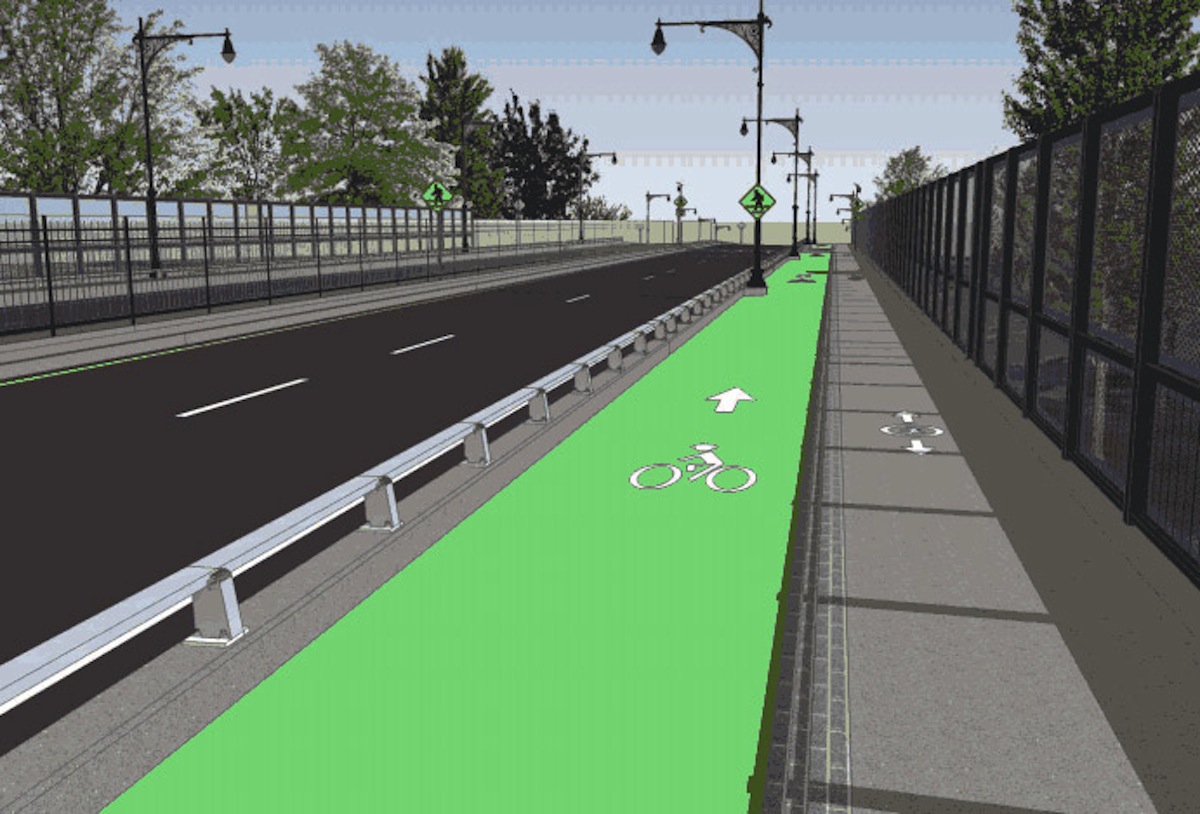Community Groups Claim ‘Victory’ in Fight for Changes to Cambridge Street Bridge

Image via MassDot
After nine months of negotiating with the state, residents and community groups in the Allston area claimed a small victory last week when MassDOT revealed the final redesign plans for the Cambridge Street bridge that passes over the Massachusetts Turnpike.
A spot that has long been a dangerous passageway for both pedestrians as cyclists, and has led to several deaths as a result of accidents between those on two wheels and those behind the steering wheel, the bridge will be getting a complete facelift over the next two years, and when it’s complete it will offer users passing over it some extra protection.
“What started as a routine bridge deck replacement project turned into a major community effort to transform a long-reviled and unsafe roadway into a more livable, human-scaled city street,” according to members of MassBike, a group that promotes safer cycling initiatives statewide, and helped bring changes to the bridge plans along with dozens of other local activists.
MassDOT first presented plans for the project in June 2013, and told residents it would be a basic deck replacement. But residents saw it as a chance to change the dangerous overpass into something that could benefit the community. “It’s come amazingly far,” said Galen Mook, organizer of Allston-Brighton Bikes. “There have been several fatalities there, it’s really harrowing. And it’s a shame because it prevents a lot of people who would be cyclists from getting out on the roads.”
But now, the bridge will feature unique bike lane separators and guards to keep riders safe from the vehicles passing by. “[The plans] separate bike traffic from car traffic with a crash barrier, so there is no chance of them getting hit,” said Mook.
According to officials from MassDOT, the project will replace the deteriorated bridge deck that carries Cambridge Street over the Turnpike and the railroad tracks in Allston. The rehabilitation project stretches from the intersection of Cambridge Street and Harvard Avenue to the intersection of Cambridge Street and Lincoln Street.
Right now, Jersey barriers shuffle pedestrians away from the oncoming traffic and the areas in the deck that have suffered substantial deterioration. “The barrier is also meant to shift the weight of vehicles toward the center of the bridge out of a concern that the outer portion of the deck on the Allston Village-bound side of the bridge may not be able to properly sustain the weight over the long term,” according to a statement from MassDOT.
Once complete, however, the bridge will be reinforced, upgraded accordingly, and will feature new barriers that separate the two sides of traffic. Beyond that, the project calls for the special crash barriers for cyclists, and a crosswalk that will make it easier for pedestrians to get from one side to the other.
“Working with the neighbors, MassDOT’s designer, Mark Gravallese, was able to incorporate many of these changes that advocates were pushing for,” said MassDOT spokesman Michael Verseckes. “The bottom line here is that this design process was a great example of MassDOT working with the neighbors to update and enhance a project so it better reflects —and accounts for—the transportation needs of today.”
This process and the changes happened as the result of several community meetings, and as Mook points out, the help of elected officials from both City Hall and the State House. “We got our elected officials to step in, which I think was a big keystone,” said Mook. “A citizen can’t do much, but they can get help from leaders.”
Verseckes said now that the community and the state have had a chance to rework the initial proposal, the project is going out to bid. The job was advertised on February 8, with work expected to begin in the summer—even as early as June. Upgrades will require two full construction seasons, so the project likely won’t be complete until 2016. The cost estimate for the project is around $10 million, according to MassDOT officials, and it’s being funded by Mass. Turnpike toll revenues.
Mook said those behind the push to make upgrades to the project are pleased with where it stands. “Some people are really happy considering where started,” he said.
MassBike Program Manager Kim Niedermaier said it was community-driven. “Significant changes would have not taken place without strong support from community advocates. It’s great to see how far the designs have changed and have improved to accommodate off-road users like bikers and pedestrians.”
But there are still some potential problems ahead. The bridge is the main artery that moves cars and vans into Allston Village during the busy September 1, move-in date. The project could divert traffic, or even make the trek more challenging. “It’s going to be insane. But, they had to do it, so regardless, construction was going to happen,” said Mook. “It’s either that, or let the bridge crumble into the Turnpike. The construction was going to happen one way or the other.”
He’s just glad the plans fell in the community’s favor. “To the credit of MassDOT, they really listened,” he said.


